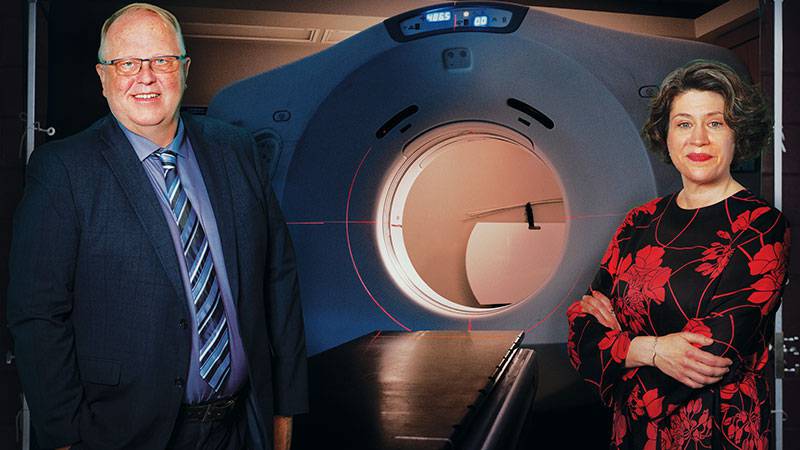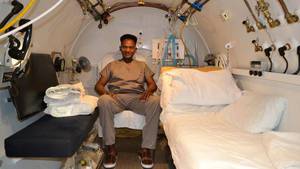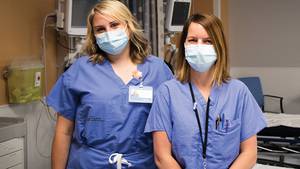Cancer rates in Nova Scotia are high — some of the highest in the country. Each year, 7,000 Nova Scotians are diagnosed with the disease, with one in two Nova Scotians facing cancer in their lifetime.
“These are our family members, our friends, our communities who are affected by cancer,” says Dr. Helmut Hollenhorst, senior medical director, Provincial Care Program at the QEII Health Sciences Centre.
Every person diagnosed with cancer faces a decision for treatment: surgery, radiotherapy or chemotherapy. More than half of those diagnosed will need radiotherapy — radiation — as part of their treatment plan. Radiation uses beams of intense energy to kill cancer cells, stopping the cells from multiplying.
According to Dr. Amanda Caissie, interim head of radiation oncology at the QEII, there are now many more reasons to use radiation to treat cancer than ever before, thanks to technological advancements and better tumour targeting.
“We’ve grown significantly in the types of cancer we can treat. Patients have a better chance of living longer with these treatments that even a few years ago we wouldn’t have been able to fathom doing,” says Dr. Caissie.
One critical piece of technology makes these life-saving treatments possible: a CT Simulator. Before any cancer patient can begin radiation treatment, they must undergo special imaging in the CT Simulator — a machine that helps their cancer care team pinpoint the exact location and shape of their tumour. The CT Simulator is the heart of radiation therapy. Without it, radiation can’t happen.
The QEII Foundation is on a mission to raise $3.6 million to bring two new CT Simulators to the QEII Cancer Centre, the largest specialized cancer centre for Atlantic Canadians.
Today, the QEII has one CT Simulator. By purchasing a second CT Simulator and replacing the current outdated model, the QEII can increase capacity to see more patients each day. This means patients can start their radiation treatments on time.
“If donors want to impact each and every patient walking into our radiotherapy centre, the CT Simulator is the one piece of equipment that will touch so many patients and families,” says Dr. Caissie.
TIMING IS EVERYTHING
Not only will adding new CT simulation technology impact approximately 3,000 patients who need radiation each year, it will also help ensure that patients don’t face delays in treatment. This is critical because when it comes to cancer, timing is everything.
“The other important piece is redundancy,” says Dr. Caissie. “If this one critical machine goes down, that limits the ability to proceed with radiation.”
A delay in radiation has a ripple effect on the entire system, including treatment delays, which can take an emotional toll on patients.
“If we have delays in radiation therapy, all the other pillars of cancer care are affected. A delay just exasperates the emotional burden on a patient with cancer and makes it intolerable,” says Dr. Hollenhorst.
LIFE-CHANGING TECHNOLOGY
Technology is ever-changing and the CT Simulator is no different. With better technology comes better treatment. Adding new state-of-the-art CT simulation technology means improved outcomes and higher cure rates for cancer patients.
“The way of the future is more individualized, high-precision radiotherapy — which means the better we can define the target we want to treat and the better we can spare healthy tissue, the higher dose of radiation we can deliver per treatment,” explains Dr. Hollenhorst. “This requires careful planning that hinges on critical imaging, like new advanced CT simulation technology.”
The benefit of higher doses of treatment has a major impact on patient care.
“The CT Simulator helps create treatment plans that maximize doses, which means fewer side effects for the patient. For some patients, it means reducing the number of radiation treatments they’ll have to undergo,” says Dr. Caissie. “So, for example, a patient may need five to 10 treatments rather than 15 to 20, which is much more convenient for them. It’s a win-win.
“A gift to support new CT simulation technology is life-changing — it will result in better outcomes for our patients,” says Dr. Caissie.
To learn more about CT simulation technology, visit: QE2Foundation.ca/CTSim.








